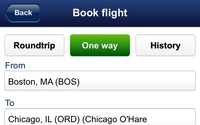 One of the most opportune places for mobile commerce is in certain
aspects of travel.
One of the most opportune places for mobile commerce is in certain
aspects of travel.
When the airlines first got into mobile, they generally mimicked what they were doing online, with the exception of any serious commerce capabilities.
That was
then.
With mobile commerce sales at $60 billion, according to the recent Millennial media travel report, airlines have been finding ways to capture more revenue via mobile means, in many ways
better serving on-the-go travelers.
As a very frequent traveler, I’ve been monitoring and using the continuing advances the airlines have been adding to their apps.
Anyone
routinely using airline apps no doubt has seen the gradual evolution of useful functions.
On the way to Boston’s Logan Airport this morning, I checked in for my American Airlines flight
to Chicago. Changing seats? No problem via the app.
Boarding pass? Ported to Passbook on my iPhone for easy check-in. Interestingly, that same boarding pass on my Android-powered Samsung
Galaxy S4 showed the flight to be on time while Passbook displayed it running late.
With the amount of air travel I do, I correctly guessed the late departure notice would be the accurate one.
(An Android refresh confirmed this).
Purchasing a seat upgrade with apps like Delta’s is a snap.
For the airlines, apps present a great upsell opportunity, especially for weary
travelers who in the course of a long journey decide they want just a little more comfort on that next leg.
Mobile boarding passes were just the beginning of the airlines’ real move to
mobile commerce.
Whether using an airline’s app to book a flight on JetBlue or British Airways, use the currency converter on United or track your bags on US Airways, airline apps for
mobile commerce are becoming highly functional commerce vehicles.
While some may have arrived late, they have arrived nicely.